IN THIS ISSUE
- Video-star manatee is back
- Portal profiles Georgia's unique wildlife
- Good time to reconnect kids and outdoors
- Teaming up at Sprewell Bluff to restore rare birds
Coronavirus details are changing frequently. Visit georgiawildlife.com and the Georgia Wildlife blog for the latest on how the DNR Wildlife Resources Division is responding to the pandemic and how that response affects outdoors recreation in Georgia, including hunting, fishing, boating, wildlife viewing and hiking.
While the agency is operational statewide, services provided online or by phone will be handled through those methods. Staff will help customers with these services.
-
Hunting, fishing and related licenses: Buy through GoOutdoorsGeorgia.com or 1-800-366-2661.
-
Lifetime sportsman licenses and commercial licenses: Email completed applications and any required documents to weblbru@dnr.ga.gov. Call 1-800-366-2661 if the option is not available for you. Also, if it’s not an option to scan applications and documents to email them, emailing clear photographs will work.
-
Boat registrations: Go to GoOutdoorsGeorgia.com or call 1-800-366-2661. (Mailed boat registration applications will not be delayed but mail is not usually as fast as the online or phone options.)
Top
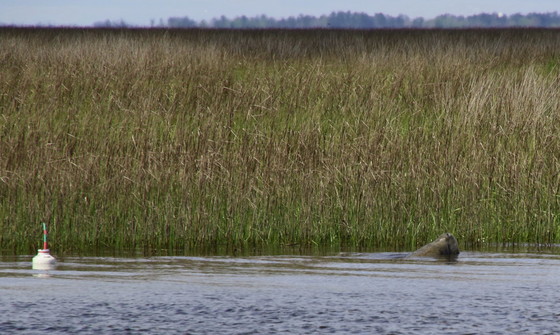 Jno, with her new tag, feeds near Ossabaw Island (Clay George/DNR, taken under FWS permit MA37808A-2)
The big manatee rescued near Savannah last October recently reaffirmed one thing:
When she’s ready to migrate, it’s best not to get in her way.
The female nicknamed Jno swam from Miami to Savannah in 30 days, an Intracoastal Waterway trip covering some 500 miles between March 3 and April 2, according to satellite transmitter data tracked by Clearwater Marine Aquarium.
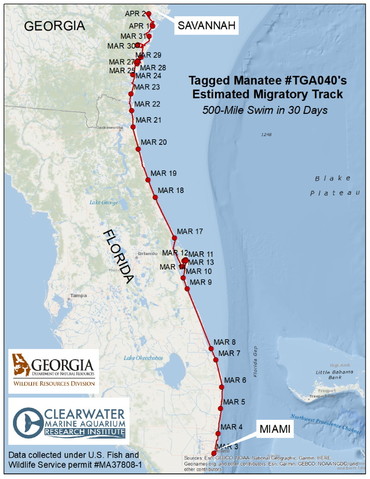
Not that the big swim was Jno’s first.
After being videoed stranded on a berm at Savannah National Wildlife Refuge and saved with the help of a dozer Oct. 1 (“Heavy-duty rescue,” October 2019), she covered more than 450 miles to Miami’s Biscayne Bay in 23 days last November.
So the relatively fast return this spring wasn’t shocking. But it did provide welcomed information on the long-range northward migrations of manatees. Researchers are also curious to see where Jno ends up.
Moving frequently between estuaries, male manatees usually have a larger summer range than females, said DNR senior wildlife biologist Clay George. Jno was rescued and first monitored – officially as TGA040 – near Savannah in the fall. At that point, though, she could already have been swimming south.
“We would expect this female is on the way to wherever her summer range is,” George said.
Late this week, she was near Savannah and continuing to make her way north.
Fortunately, George and DNR’s Trip Kolkmeyer caught up with her and swapped out the old tag for a new one, giving scientists a better shot at shadowing Jno to her summer home.
|
BOATERS: MANATEE WATCH IS ON
With coastal waters warming earlier than usual this late-winter and early spring, manatees have shown up sooner along Georgia’s coast. Boaters are encouraged to:
- Practice safe boating for manatees by slowing down near the shoreline and when in shallow waters.
- On seeing a manatee, give them space, do not pursue them and never give them food or water.
Boat strikes are a leading cause of manatee injuries and deaths. Boaters who hit one should stand by and immediately call DNR at 800-2-SAVE-ME (800-272-8363).
Top
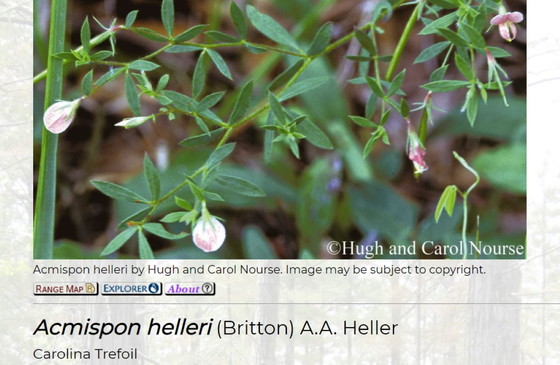 Looking for information on rare animals or plants in your county? How about where such species are found statewide, their natural history and even why they’re rare?
Look no further than the Georgia Biodiversity Portal, DNR’s ever-widening web-based window into native wildlife and habitats that are protected or otherwise tracked for conservation purposes.
The portal provides current, scientist-vetted data on rare species and natural communities, from the herb Carolina trefoil to green salamanders and maritime swamp forests. Included are full or basic profiles, rarity rankings, state and federal listing status, and interactive range maps color-coded by when the species or plant community was last documented.
Greg Krakow, biodiversity conservation data manager for DNR’s Wildlife Conservation Section, said the portal has been in the works for years. “We’re expanding the scope of it all the time.”
The portal features nearly 2,000 elements, including species and natural communities. While the focus is on protected wildlife and other creatures and habitats listed as a conservation priority in the State Wildlife Action Plan, the website also includes information on common species when that data is available. For example, users can access profiles, photographs and range maps for all of Georgia’s native and introduced crayfish species.
As Krakow notes, more updates are in the works. The agency hopes to add all of the state’s bats and freshwater fishes and mussels using data collected by DNR and collaborators from around the state.
Meanwhile, traffic on the portal is surging. Visits increased more than 1,000 percent during the last few months.
Wildlife Conservation Section Program Manager Dr. Brett Albanese said he has heard from users varying from transportation agency ecologists to public school students. “It’s a great starting point for comprehensive information on Georgia’s rare species.”
Top
 Eastern box turtle (Guerry Doolittle/Georgia Nature Photographers Association)
By TERRY W. JOHNSON
The spread of COVID-19 is having an unimaginable impact on our lives. In an effort to stave off the spread of the dreaded disease, we all are making changes that are significant and challenging.
But while we're staying home, I would like to suggest a worthwhile endeavor you and your family can do together: Foster an appreciation of nature in your children. Use this time to address the issue of kids losing touch with the outdoors. (One study found that while the average 10- to 14-year-old can recognize 1,000 corporate logos, they cannot identify 10 plants that grow nearby.)
There is no better place to begin this journey of discovery than in your backyard. Because many Georgia yards are home to an amazing variety of plants and animals, they make ideal outdoor classrooms. …
Read Terry’s full column for tips on exploring the outdoors with your family.
Terry W. Johnson is a retired DNR program manager and executive director of TERN, the Wildlife Conservation Section’s friends group. Check out past columns, his Backyard Wildlife Connection blog and his book “A Journey of Discovery: Monroe County Outdoors.” (Permission is required to reprint this column.)
MORE OUTDOOR ED OPTIONS
Recommended outlets for backyard wildlife information also include:
Top
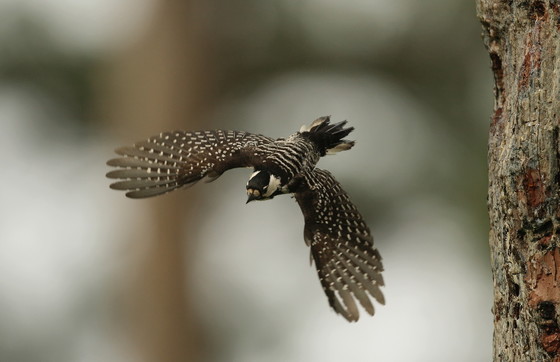 Red-cockaded woodpecker (Martjan Lammertink/USFS)
Home to unique plants, animals and habitats, middle Georgia’s Sprewell Bluff is a special place.
But a partnership between DNR and CatchMark Timber Trust promises to make the 6,495-acre wildlife management area along the Flint River even more special.
The focus is restoring longleaf pine habitats to reintroduce red-cockaded woodpeckers, an endangered bird not seen at Sprewell Bluff in decades.
Read about the conservation teamwork in this blog post by DNR’s Beth Quillian.
Top
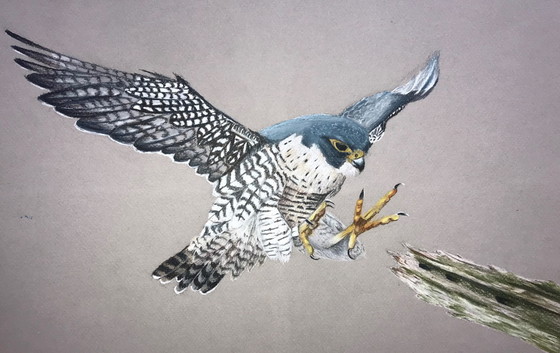 Alson Li's peregrine falcon proved the 2020 Youth Birding art grand-prize winner.
Amazing is one way to describe the leading entries in the Youth Birding Competition’s T-shirt Art Contest segment. DNR recently announced the winners (see their work).
Out of safety concerns regarding the coronavirus, the Youth Birding Competition itself has been postponed from April 24-25 to Aug. 29-30. DNR also moved the registration deadline to July 31 and announced that high school seniors will remain eligible to compete in the postponed event.
Give Wildlife a Chance Poster Contest entries can be submitted electronically by April 10, instead of only through the mail. DNR and the State Botanical Garden of Georgia made the change in light of the pandemic. Details at georgiawildlife.com/PosterContest.
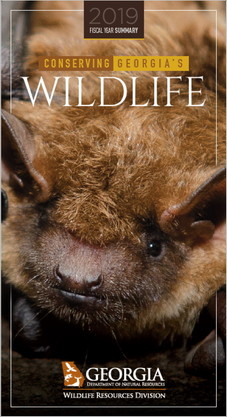
The U.S. Forest Service has temporarily closed all dispersed camping corridors, day-use areas, trailhead facilities and other recreation sites on the Chattahoochee National Forest in Lumpkin, Fannin, Union and Towns counties. The service's public safety measures involving the Chattahoochee and Oconee national forests are updated here and on Facebook.
From bald eagles to mountain bogs, the latest annual report from DNR's Wildlife Conservation Section features a year of stories, insights and images covering wildlife work statewide. The fiscal year 2019 report is available in summary and comprehensive versions.
The calving season for North Atlantic right whales totaled 10 calves seen in the Southeast (one was injured by a boat strike and is presumed dead). With the endangered whales returning to Northeast and Canadian waters for summer, the last survey flight off Georgia and Florida was conducted this week. (In the next Georgia Wild: right whale-season recap).
Six wildlife-viewing projects have been announced as 2020 grant recipients in DNR’s Wildlife Viewing Grants Program. Ranging from Savannah to Atlanta and featuring additions from binoculars to pollinator gardens, the work will provide opportunities for the public to enjoy wildlife, particularly species and habitats emphasized in Georgia’s State Wildlife Action Plan.
The osprey nest live-streamed from The Landings near Savannah has three eggs and two busy adults. And while the Berry College bald eagles suffered a failed nest this winter, the parents are occasionally seen on Berry’s nest cams, as was this sub-adult eagle.
|
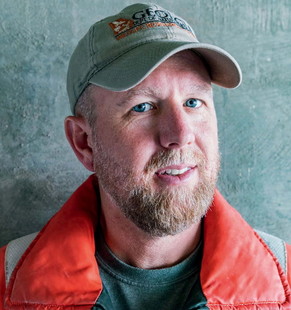
Names in the news: Garden & Gun named Wildlife Conservation Section senior biologist Clay George (right) one of its 30 Southern heroes for his and DNR’s work to conserve North Atlantic right whales, one of the world's most imperiled whale species. The Charleston, S.C.-based magazine with a readership exceeding 1 million includes George, “the whale watcher,” among the likes of novelist and poet Wendell Berry, singer/songwriter Darius Rucker, and Sara Ross, Wormsloe Foundation President and heirloom seeds advocate. Ted Will has been appointed assistant director of the DNR Wildlife Resources Division. Will, who previously served as Game Management Section chief, will fill the vacancy left by former Assistant Director Mark Whitney, who retired.
|
WHAT YOU MISSED ...
In the previous Georgia Wild:
- Adding conservation lands
- Pocket gophers up close
- Winterizing yards for wildlife
- Aid to injured whale calf videoed
Top
"Whales face more fatal ship collisions as waters warm," Associated Press
"New rules introduced to protect right whales," WABE-FM (90.1, Atlanta)
More right whale news: Satellite tracking to help avoid entanglements (Discover); Entangled whale in poor condition (The Inquirer and Mirror, Nantucket, Maine); Aquarium debuts improved whale catalog (Daily Times, Gloucester, Mass.); Whale, calf seen off Keys (Key West Citizen, Fla.)
"Duluth eighth-grader's artwork wins birding T-shirt contest," Gwinnett Daily Post
"DNR awards six wildlife viewing grants," Albany Herald
"Group wants to restore prairie grasslands in Piedmont," Atlanta Journal-Constitution
"DNR Youth Birding Competition postponed," The Citizens (Rockdale, Newton counties)
"Bird habitat restoration receives grant for Big Creek Greenway," Alpharetta-Milton Patch
"Poll: strong support for domestic cat management," American Bird Conservancy
(+video) "Panola 'morphs' into red landscape," Fox5 (WAGA-TV, Atlanta)
"Blairsville man pleads guilty to poisoning wildlife," Cherokee Tribune & News Ledger (Canton)
"Biology grad students seek to improve environment in their research," The George-Anne (Georgia Southern University)
"Bee lawns generate national buzz," PEW Charitable Trusts
Top
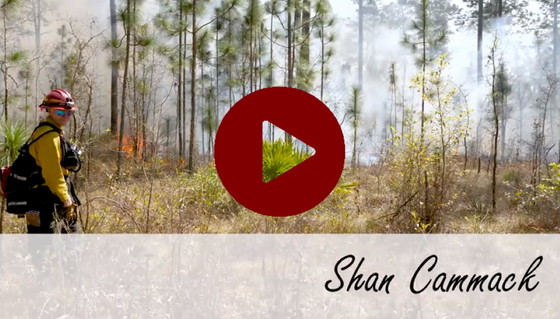 VIDEO
"The Women of Georgia Wildlife: Shan Cammack" and "Katrina Morris," DNR
"Ancient bald cypress of Black River, N.C.," Ancient Bald Cypress Consortium
"Nearly blind baby shrews form conga line to survive," Nat Geo WILD
"Talking Nature Tuesday (teaser)," DNR
Top
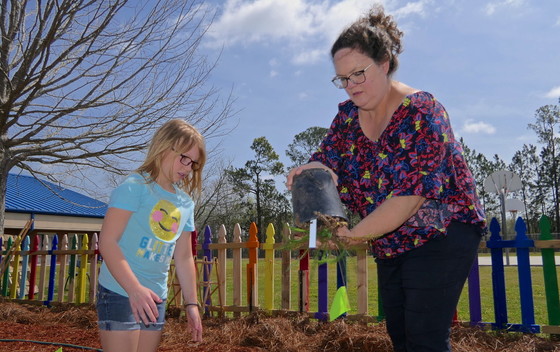 Stephanie Hodges, 2019 recipient of DNR’s Conservation Teacher of the Year grant, helps one of her students plant yarrow in a “pollinator paradise” garden at south Georgia's Portal Elementary, before schools closed statewide.
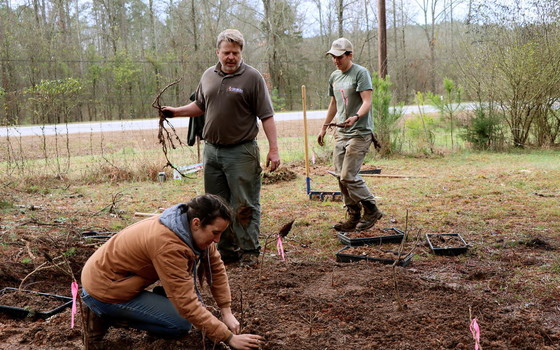 As part of a March outing with author Georgann Eubanks and photographer Donna Campbell, DNR’s Dr. J. Mincy Moffett Jr. and Morgan Bettcher work with Beech Hollow Farms’ Clair Eisele to create a safeguarding site for dwarf sumac. Eubanks is including a chapter about DNR and Georgia Plant Conservation Alliance efforts to conserve the endangered plant in her upcoming book “The Wild South: Lost and Found.”
 This curious cottonmouth (aka water moccasin) was photographed in Bulloch County last month by DNR’s Matthew Moore.
CREDITS
Masthead: green salamander (John Jensen/DNR)
Clay George (Peter Frank Edwards/Garden & Gun)
Stephanie Hodges and student (Linda May/DNR)
Planting dwarf sumac (Donna Campbell)
Top
|